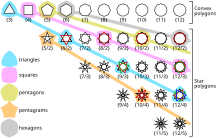|
Complex polygon
The term complex polygon can mean two different things:
GeometryIn geometry, a complex polygon is a polygon in the complex Hilbert plane, which has two complex dimensions.[1] A complex number may be represented in the form , where and are real numbers, and is the square root of . Multiples of such as are called imaginary numbers. A complex number lies in a complex plane having one real and one imaginary dimension, which may be represented as an Argand diagram. So a single complex dimension comprises two spatial dimensions, but of different kinds - one real and the other imaginary. The unitary plane comprises two such complex planes, which are orthogonal to each other. Thus it has two real dimensions and two imaginary dimensions. A complex polygon is a (complex) two-dimensional (i.e. four spatial dimensions) analogue of a real polygon. As such it is an example of the more general complex polytope in any number of complex dimensions. In a real plane, a visible figure can be constructed as the real conjugate of some complex polygon. Computer graphics  In computer graphics, a complex polygon is a polygon which has a boundary comprising discrete circuits, such as a polygon with a hole in it.[2] Self-intersecting polygons are also sometimes included among the complex polygons.[3] Vertices are only counted at the ends of edges, not where edges intersect in space. A formula relating an integral over a bounded region to a closed line integral may still apply when the "inside-out" parts of the region are counted negatively. Moving around the polygon, the total amount one "turns" at the vertices can be any integer times 360°, e.g. 720° for a pentagram and 0° for an angular "eight". See alsoReferencesCitations
Bibliography
External links
|
Portal di Ensiklopedia Dunia





